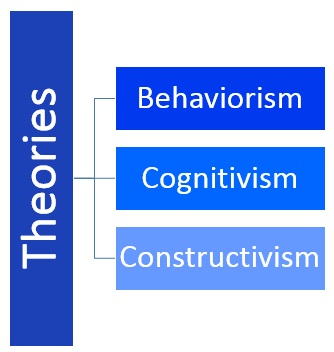Learning involves physically changing people’s minds because the synapses in the human brain connect the information to form their recognition of the environment. As the connections embed deeply in people’s minds, which makes them more likely to reject the changes in opinions even if they are incorrect; therefore, learning design plays an essential role in overcoming the problem of confirmation bias.
Learning design involves customizing learning processes for different individuals to raise their willingness to change ideas through learning; learning theories could help with it by identifying the learners’ most suitable strategies, materials, and needs. Three learning theories with different features include behaviorism, cognitivism, and constructivism. A scenario of “a high school social study teacher is planning a class on climate change” introduces the differences between the theories’ applications. As the reading mentioned, behaviorists “work with reinforcement and feedback to develop habits in their learners” (Ertmer et al., 2013), which means it focuses on the idea that all behaviors and information are learned through interactions with the environment. Different behaviors are responded to according to the various situations that the learners experience. By applying this model to the scenario, the high school teacher chooses to reinforce the students positively by awarding them when they did well on the climate change tests. Therefore, the students could learn that good performance on tests equals getting rewards. Consequently, they would work hard and study for their examination to get the prize. The purposes of raising their motivation in learning and consolidating knowledge are achieved. Cognitivists help the learners “uncover and use appropriate learning strategies and make connections to prior understandings” (Ertmer et al., 2013), which means it focuses on how information is received, organized, stored, and retrieved by the mind. By applying this model to the scenario, the high school teacher may design the course with in-class discussion sessions and bring the climate change-related questions that require the students to recall and connect the previous and present information to answer. Finally, the constructivists trust “the learners make their own meaning and interpretations based on individual experiences and interactions” (Ertmer et al., 2013), which means the constructivist learning model prefers to make the learners recognize and interpret the information by themselves through exploring in the real-world environment. By applying this to the scenario, the high school teacher may lead the students outside the classroom and let them regularly observe the climate changes around them for a year. It could be once a month or once a week, but it needs to be in the same place and at the same time for each observation.
From my experiences, I prefer the constructivism learning model as I enjoy the process of flexible self-exploration. I took EDCI 337 in the summer of 2020, and this course allowed me to build video games and whiteboard animations to reflect and display my personal interpretation of learning design. The process of creating these interesting projects really engaged me and helped me identify my learning style.
Reference:
Ertmer, P. A., Newby, T., Ertmer, Newby, & West, R. E. (2013). Behaviorism, Cognitivism, Constructivism. edtechbooks.org. https://edtechbooks.org/lidtfoundations/behaviorism_cognitivism_constructivism
COMMENT ON WANQIN’S BLOG POST #1
Link to the post: https://wanqinjiang68.opened.ca/2023/05/28/blog-post-1-learning-motivation-and-theory/
Hi Wanqin,
Thanks for sharing your fantastic post! I strongly agree that bridging the learning research and theories with actual educational practice is significant in improving the learning process because different learning theories present various styles of learning processes which fit different types of learners. The major application of learning theory is customizing the learning processes for diverse individuals, increasing their motivation to study new knowledge and changing their minds, and finally reducing their confirmation bias and consolidating their knowledge bases. The higher the motivation is, the more engagement the learners present, and a more effective learning process could be conducted. Therefore, learning theory also plays an essential role in raising motivation. As you mentioned, “learning strategy by accomplishing a proper response following an environmental stimulus and guide from cues,” I feel connected with your opinion and the example from my work. When the teacher awards the students who got good grades on their tests, all the students obtain a cue that good performance on the test equals the award. Therefore, they are guided and stimulated by the cue to perform the behaviors such as hard-working on the study in order to achieve the goal of getting the award.
Angel Liu

wanqinjiang May 28, 2023
Hi Angel! I really enjoy reading your posts and think it is insightful! I had a very similar perspective to you about the three learning strategies, especially for constructivism, which is a strategy for learners to make interactions with learning materials and create meanings based on their own experiences, for example, a Tedtalk presentation is a good way for constructivism learning since it can inspire learners to look back their past experience and create their own reflections.